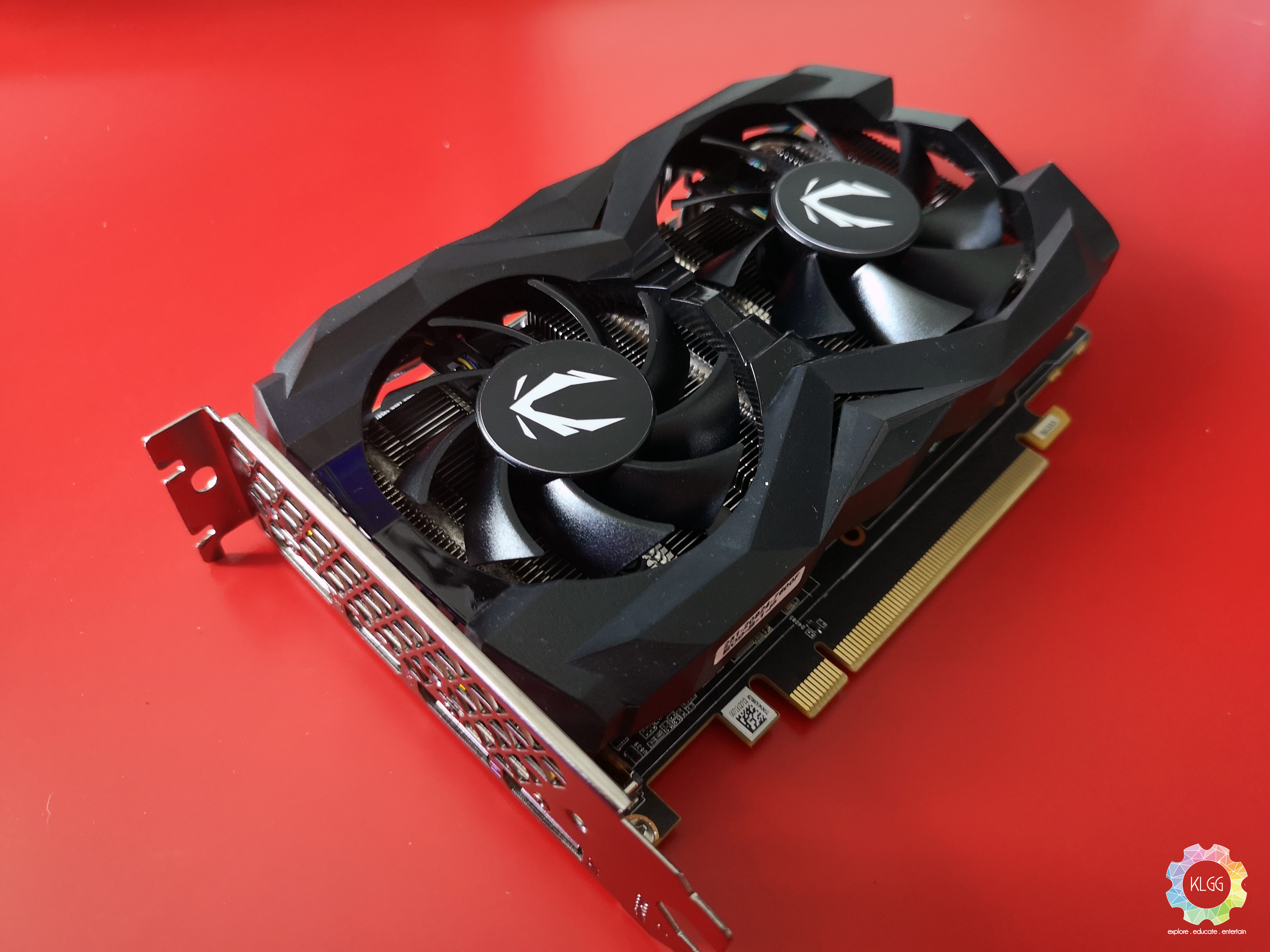Fancy a new GPU but don’t want RTX? You’ve come across the GPU that might just be the one for you! The NVIDIA GTX 1660 launched with pretty little fanfare compared to its RTX brethren, neatly replacing the GTX 1060 and providing gamers with the new value option in the Turing lineup. We’ve got the ZOTAC GTX 1660 Firestorm in hand to put through its paces. Does this Tensor-absent & RT-less card live up to the legacy of its GTX predecessor?
Spec Sheet
| GPU Architecture / Chip | Turing / TU116 | Shaders | 1408 |
| Variant | TU116-300-A1 | TMUs | 88 |
| Foundry | TSMC | ROPs | 48 |
| Transistors | 6.6 billion | Tensor Cores | N/A |
| Clock Speed | 1530 Mhz | RT Cores | N/A |
| Boost Clock | 1785 Mhz | Memory | 6 GB GDDR5 |
| Die Size | 284 mm2 | Bus | 192-bit |
| Memory Clock | 2001Mhz (8 GHz effective) | Bandwidth | 192.1 GB/s |
| TDP | 120W | Outputs |
|
| Power Connector | 8-pin | Width | Dual-Slot |
| Dimensions | 229mm (L) x 113mm (H) | Giga Rays /s | N/A |
| Pixel Rate | 85.68 GPixels/s | Texture Rate | 157.1GTexels/s |
The Basics
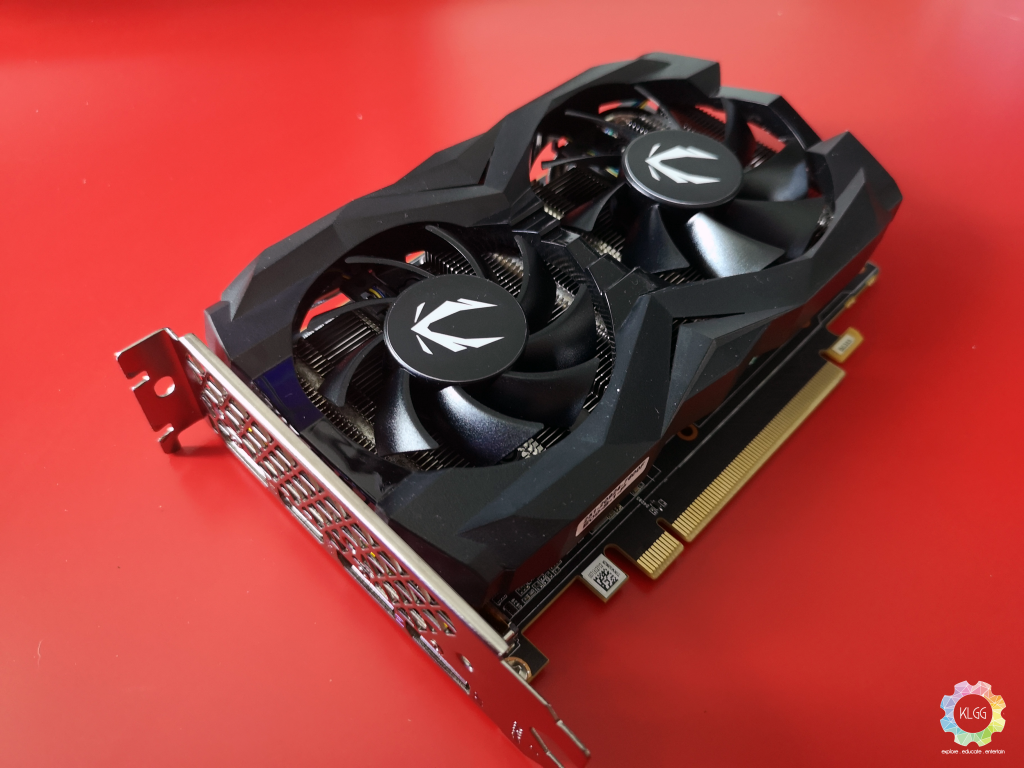 As anyone who’s bought a ZOTAC card in the previous 3 to 4 years will attest to, ZOTAC’s standard dual-fan blower solution is implemented here without much fanfare. A mix of gunmetal grey with black fans and a black PCB give the GTX 1660 a sleek, understated look, with very little in the way of bells, whistles and flash.
As anyone who’s bought a ZOTAC card in the previous 3 to 4 years will attest to, ZOTAC’s standard dual-fan blower solution is implemented here without much fanfare. A mix of gunmetal grey with black fans and a black PCB give the GTX 1660 a sleek, understated look, with very little in the way of bells, whistles and flash.
Powered by a single 8-pin connector placed on the front/top of the card (as opposed to the RTX 2060’s rather weird back-placement), the GTX 1660 has a much smaller footprint compared to the its RTX big brother, with overall length just a little under 7 inches / 17.4cm. Proof that size isn’t everything? (hey, stop giggling at the back).
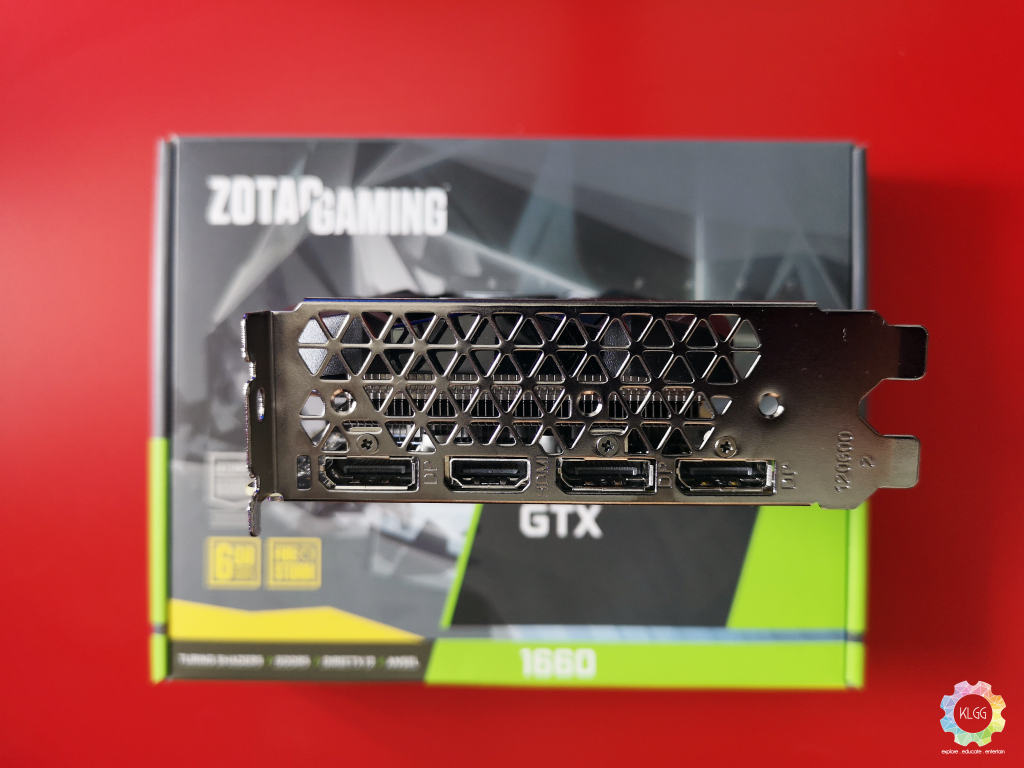 On the rear of the card, the outputs denote the rather budget-oriented positioning of the GTX 1660, with 3x DisplayPports and 1x HDMI. No DVI or USB-C here, meaning that its VR-ready moniker is not meant for VirtualLink.
On the rear of the card, the outputs denote the rather budget-oriented positioning of the GTX 1660, with 3x DisplayPports and 1x HDMI. No DVI or USB-C here, meaning that its VR-ready moniker is not meant for VirtualLink.
Plug this little number into your motherboard via a PCIe x16 connector, and the GTX 1660 will work with anything from the last 7 to 8 years of platforms from intel or AMD.
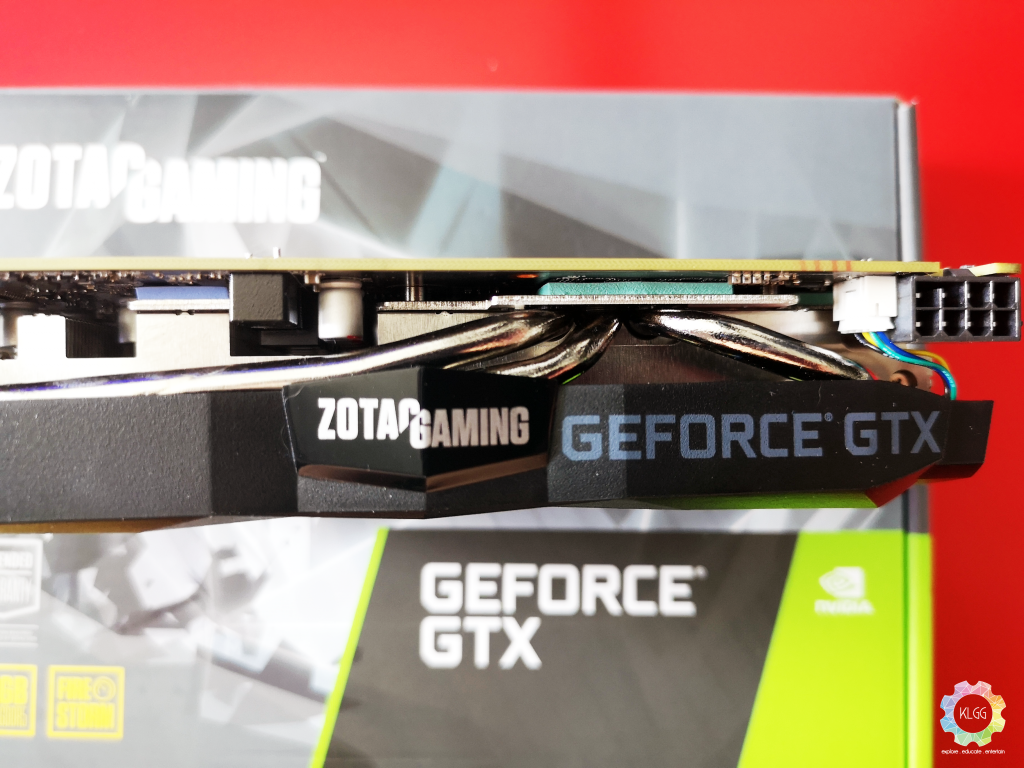 In comparison to the Founders Edition of the RTX line, the GTX 1660 looks… humdrum? It looks like any other ZOTAC card that’s already out on the market, with nothing to really distinguish it from ZOTAC’s other offerings. This calls to mind BMW’s ‘same sausage, different lengths’ design philosophy that plagued its models in the mid to late 90s, giving it a comforting sameness / bland familiarity (delete where applicable).
In comparison to the Founders Edition of the RTX line, the GTX 1660 looks… humdrum? It looks like any other ZOTAC card that’s already out on the market, with nothing to really distinguish it from ZOTAC’s other offerings. This calls to mind BMW’s ‘same sausage, different lengths’ design philosophy that plagued its models in the mid to late 90s, giving it a comforting sameness / bland familiarity (delete where applicable).
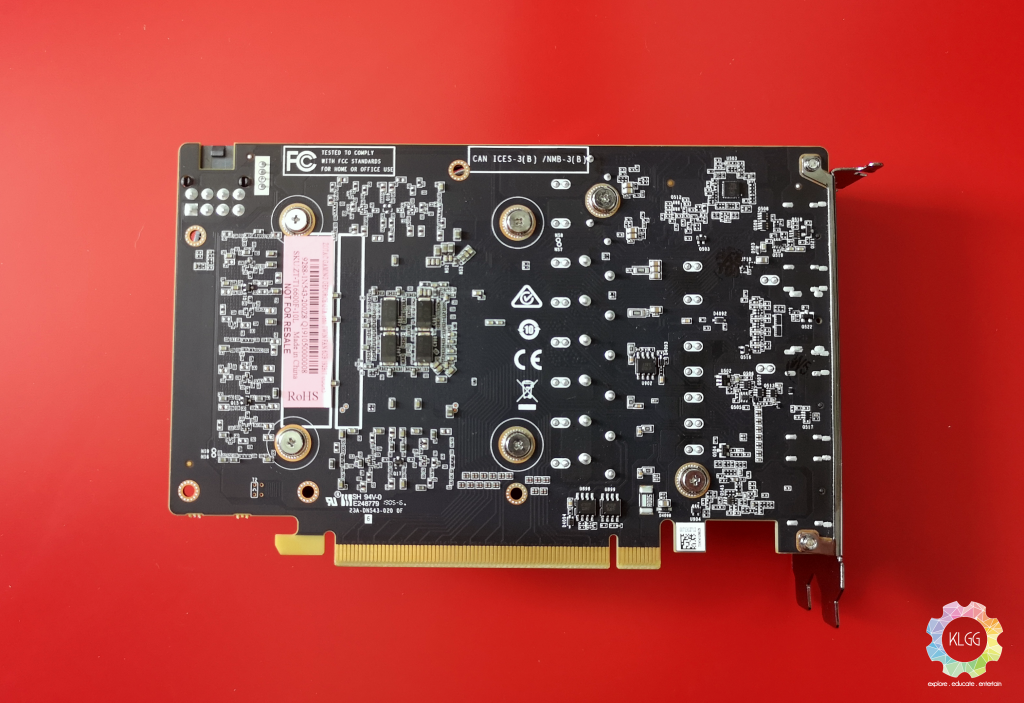 ZOTAC’s cooling solutions are also not always the best-performing, which gives me a concern or two before we get into testing. The other concern? The decision to use GDDR5 memory instead of the newer GDDR6 memory that you’ll find on the RTX line. I suspect its to keep costs down, but this is probably going to be at the cost of performance.
ZOTAC’s cooling solutions are also not always the best-performing, which gives me a concern or two before we get into testing. The other concern? The decision to use GDDR5 memory instead of the newer GDDR6 memory that you’ll find on the RTX line. I suspect its to keep costs down, but this is probably going to be at the cost of performance.
Let’s see what the numbers say.
Benchmarks – Methodology
Where possible, in-game / software benchmarks were used to give a consistent representation of the performance of the cards being tested. FIVE (5) runs were carried out at various settings / resolutions. The highest and lowest recorded FPS / score readings were discarded (to reduce the possibility of outliers), and an average of the three readings is then taken.
If there is no in-game benchmark available, then a repeat run of a certain portion of the game would be used, making sure that the portion in question would have an accurate cross-section of various game scenarios. FPS readings would then be recorded via CSV data collated from Razer Cortex, and averaged out accordingly.
All tests were carried out on our test bench (mentioned below), which is water-cooled via a Bykski custom-loop with two 360mm radiators to prevent any possible temperature bleed.
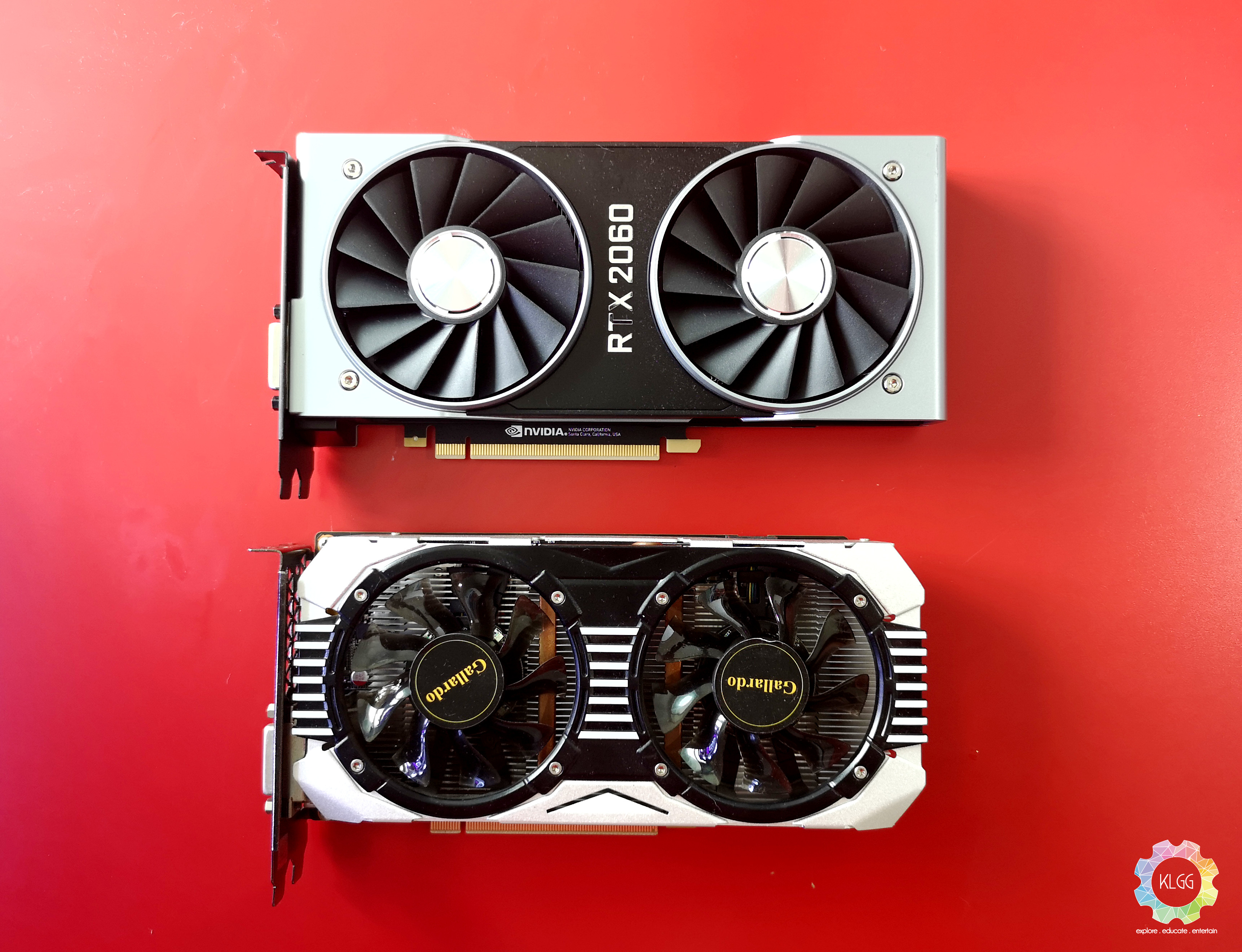 Three cards were used in benchmarks aside from the GTX 1660. Our main test bench card, a ZOTAC NVIDIA GeForce GTX 1080TI Mini, is also water-cooled. The next card in our line-up is a Manli GTX 1060 6GB Gallardo, running on a stock cooling solution. The RTX 2060 FE has been added to the database for comparison.
Three cards were used in benchmarks aside from the GTX 1660. Our main test bench card, a ZOTAC NVIDIA GeForce GTX 1080TI Mini, is also water-cooled. The next card in our line-up is a Manli GTX 1060 6GB Gallardo, running on a stock cooling solution. The RTX 2060 FE has been added to the database for comparison.
Test Bench
| CPU | Ryzen 7 2700X (water-cooled) |
| Motherboard | ASUS ROG Crosshair VII Hero Wi-Fi |
| Chipset | X470 |
| Memory | 16GB DDR4 OC’ed @3466MHz (Patriot VIPER RGB) |
| Graphics Card (comparison) | ZOTAC NVIDIA GeForce GTX 1080Ti Mini (water-cooled) NVIDIA RTX 2060 Founders Edition ZOTAC NVIDIA GTX 1660 Firestorm |
| SSD | OS : M.2 – Pioneer APS-SM1 (240GB) Gaming SSD – LiteOn 512GB |
| PSU | Cooler Master G650M Semi Modular 650W |
| Monitor | Samsung LU28E590DS
|
Benchmark Results – Games
Grand Theft Auto V
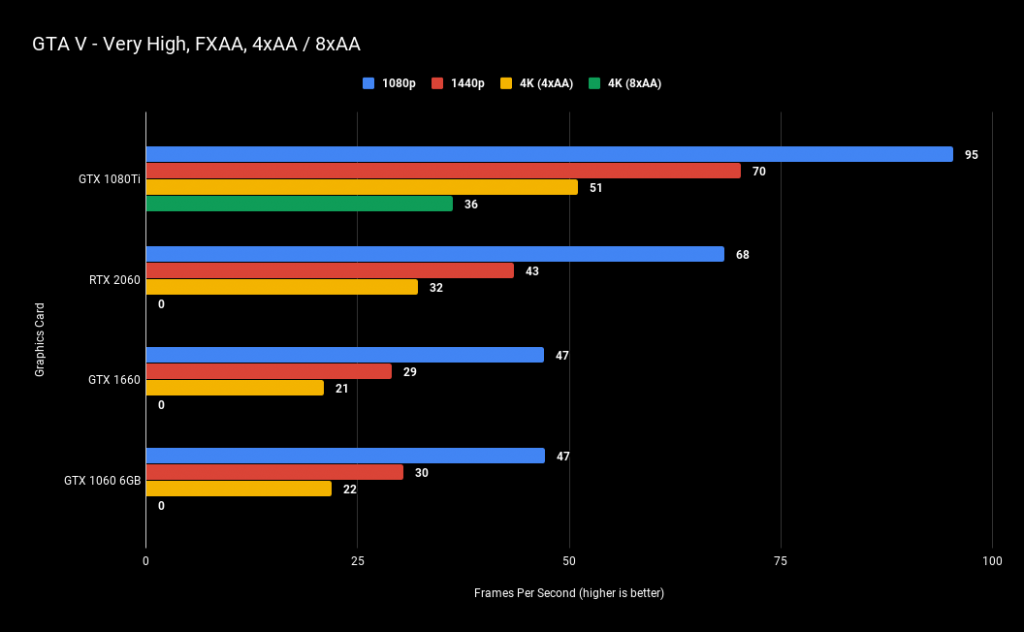 As mentioned previously, GTA V might be an old benchmark, but it really does push modern hardware to the limit. This is borne out in the numbers, with the GTX 1660 and the GTX 1060 in a virtual dead heat. Carrying the same memory configuration (6GB of GDDR5 VRAM) while battling a very memory-intensive game, the result is disappointing but not really surprising.
As mentioned previously, GTA V might be an old benchmark, but it really does push modern hardware to the limit. This is borne out in the numbers, with the GTX 1660 and the GTX 1060 in a virtual dead heat. Carrying the same memory configuration (6GB of GDDR5 VRAM) while battling a very memory-intensive game, the result is disappointing but not really surprising.
The RTX 2060 by comparison outpaces the GTX 1660 by 45% at 1080p, 48% at 1440p, and 52% at 4k (4xAA). The GTX 1080Ti at this point is already on a different planet before the GTX 1660 has even left Los Santos.
F1 2018
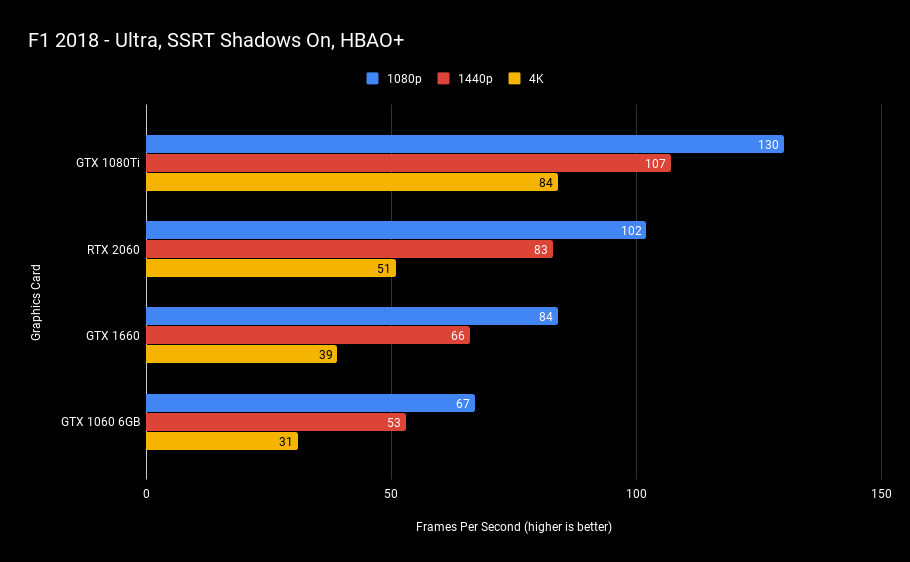 F1 2018 is an example of a beautiful game that has been optimised fantastically well. Game performance scales very well at any resolution, as evidenced by our numbers. Here, the GTX 1660 slots neatly between the GTX 1060 and RTX 2060 – beating the GTX 1060 by 25% (1080p), 25% (1440p) and 26% (4K). The gap to RTX 2060 is 21% (1080p), 26% (1440p) and 31% (4K). The GTX 1080Ti really puts the perfomance gap into perspective, with a relative difference of 55% at 1080p, 62% at 1440p and 115% at 4K.
F1 2018 is an example of a beautiful game that has been optimised fantastically well. Game performance scales very well at any resolution, as evidenced by our numbers. Here, the GTX 1660 slots neatly between the GTX 1060 and RTX 2060 – beating the GTX 1060 by 25% (1080p), 25% (1440p) and 26% (4K). The gap to RTX 2060 is 21% (1080p), 26% (1440p) and 31% (4K). The GTX 1080Ti really puts the perfomance gap into perspective, with a relative difference of 55% at 1080p, 62% at 1440p and 115% at 4K.
Having said that, the GTX 1660 still offers playable framerates even at 4K, which is a staggering achievement for such a budget-oriented offering.
Assassin’s Creed : Origins
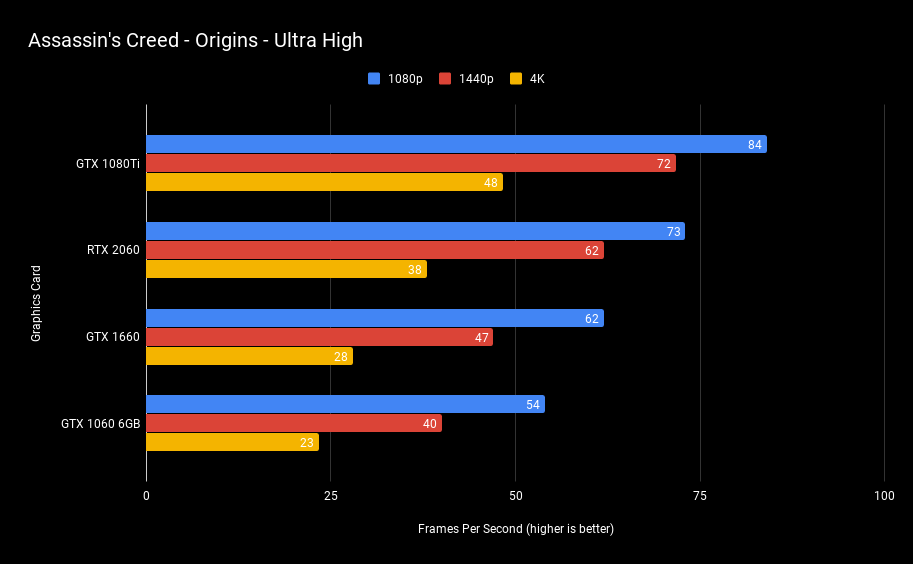 As we’ve noted previously, AC: Origins is a weird GPU/CPU dependent title that throws up interesting results. Not that there’s much surprise in how the GTX 1660 performs – it once again slots into the gap between GTX 1060 and RTX 2060. The performance vs 1060 gives a generational improvement of 15% (1080p), 18% (1440p) and 22% (4K). The gap to RTX 2060 goes from 18% (1080p) to 32% (1440p) and 36% (4K).
As we’ve noted previously, AC: Origins is a weird GPU/CPU dependent title that throws up interesting results. Not that there’s much surprise in how the GTX 1660 performs – it once again slots into the gap between GTX 1060 and RTX 2060. The performance vs 1060 gives a generational improvement of 15% (1080p), 18% (1440p) and 22% (4K). The gap to RTX 2060 goes from 18% (1080p) to 32% (1440p) and 36% (4K).
As a testament to the faster VRAM in the RTX 2060 (which kept the gap to the GTX 1080Ti relatively respectable at 14% (1080p & 1440p), the decision to use GDDR5 really hurts the GTX 1660’s performance here.
Shadow Of The Tomb Raider
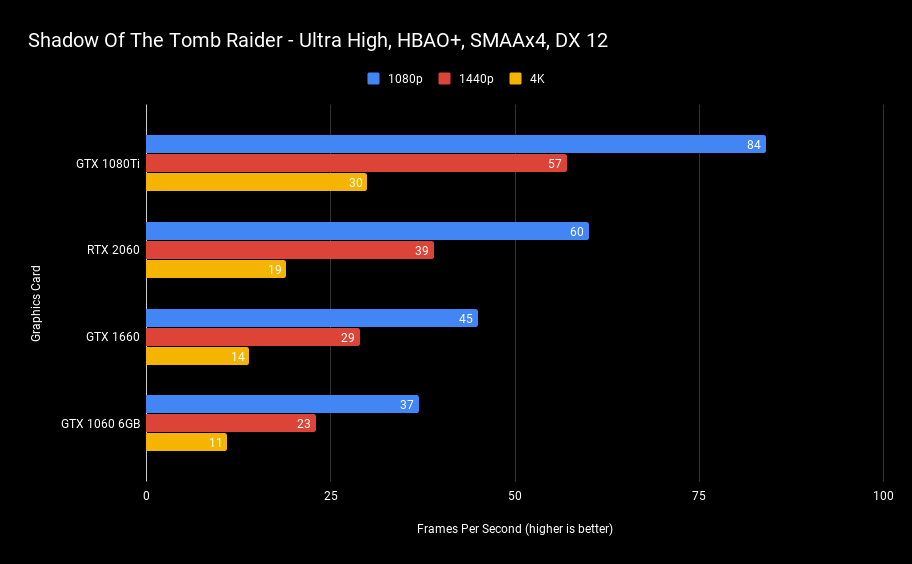 Shadow of The Tomb Raider performance stays true to the trend that we’ve seen established with prior testing, as the GTX 1660 finds a natural home between the 1060 and RTX 2060. Outpacing the GTX 1060 by 22% (1080p), 26% (1440p) and 28% (4K), but losing out to the RTX 2060 by 33% (1080p), 34% (1440p) and 36% (4K), the GTX 1660 really shows its obvious budget roots.
Shadow of The Tomb Raider performance stays true to the trend that we’ve seen established with prior testing, as the GTX 1660 finds a natural home between the 1060 and RTX 2060. Outpacing the GTX 1060 by 22% (1080p), 26% (1440p) and 28% (4K), but losing out to the RTX 2060 by 33% (1080p), 34% (1440p) and 36% (4K), the GTX 1660 really shows its obvious budget roots.
4K performance is basically non-existent for this hardware configuration, so please don’t bother. The GTX 1080Ti is way off into the distance, although instead of the Flash vs Commissioner Gordon, this is the Flash vs Jimmy Olsen.
Battlefield V
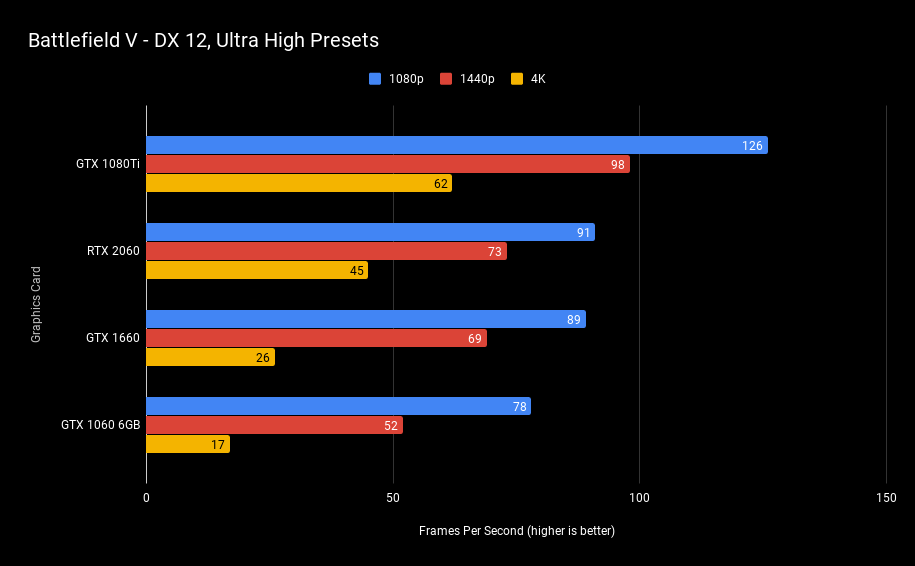 A multiplayer game like BF V will prioritise FPS to deliver a smooth gaming experience (a critical aspect of twitch shooters) and the GTX 1660 delivers this right up to 1440p. 4K performance is barely serviceable, confirming our assumption that this really isn’t a 4K capable card.
A multiplayer game like BF V will prioritise FPS to deliver a smooth gaming experience (a critical aspect of twitch shooters) and the GTX 1660 delivers this right up to 1440p. 4K performance is barely serviceable, confirming our assumption that this really isn’t a 4K capable card.
With a gap of 14% (1080p), 33% (1440p) and 53% (4K, but also at a rather useless framerate), the GTX 1660 offers reasonable generational improvement compared to its predecessor. The gap to RTX 2060 is remarkably close at 1080p (less than 3 fps), and is 6% at 1440p, before widening massively to 73% at 4K.
Benchmark Results – Software / Rendering
3DMark – TimeSpy, DX12, 1440p
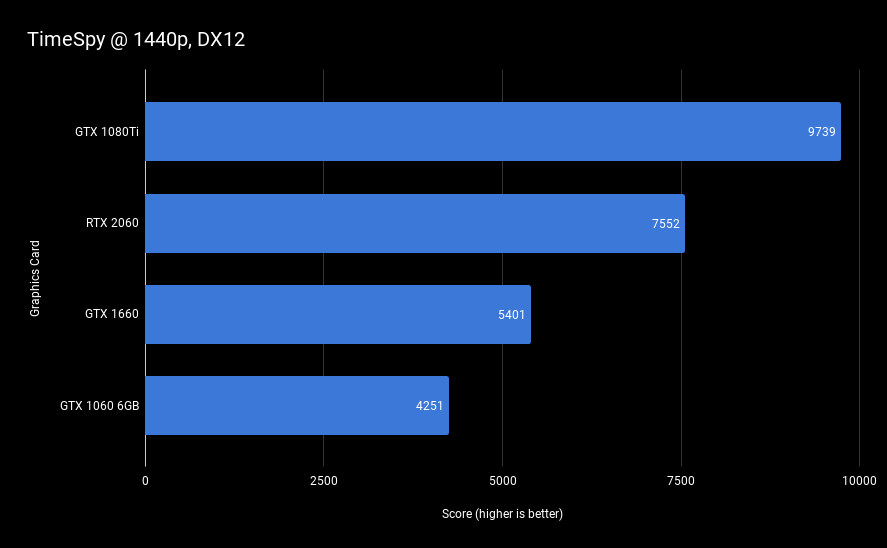 3DMark’s TimeSpy synthetic benchmarks offer a straightforward comparison for performance levels. Here, the GTX 1660 performs 27% better than the GTX 1060, while lagging by 40% behind the RTX 2060.
3DMark’s TimeSpy synthetic benchmarks offer a straightforward comparison for performance levels. Here, the GTX 1660 performs 27% better than the GTX 1060, while lagging by 40% behind the RTX 2060.
3DMark – TimeSpy Extreme, DX12, 4K
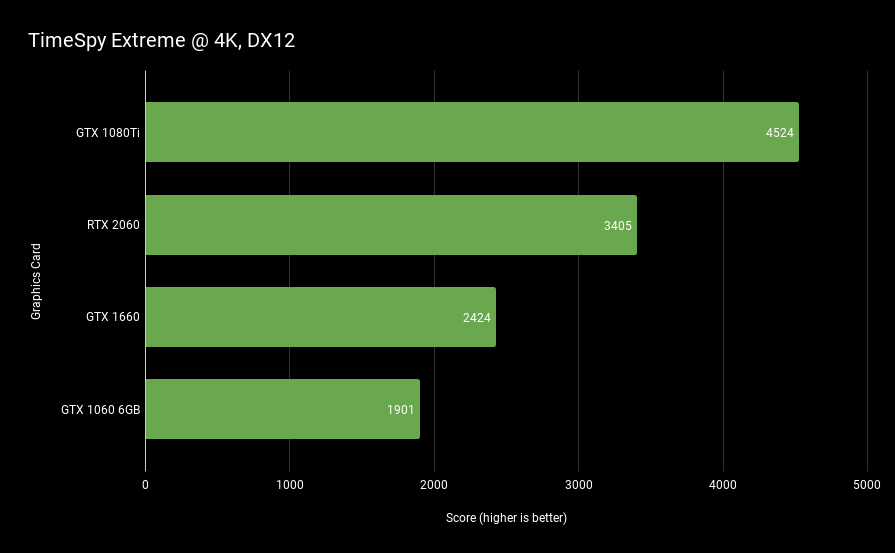 As mentioned previously, 4K performance for the GTX 1660 is not exactly laughable – it’s a bit cringeworthy instead, like a Michael Scott joke that doesn’t make sense. While there’s a 28% performance gap over the GTX 1060, the 40% deficit to the RTX 2060 is a punchline no one will enjoy.
As mentioned previously, 4K performance for the GTX 1660 is not exactly laughable – it’s a bit cringeworthy instead, like a Michael Scott joke that doesn’t make sense. While there’s a 28% performance gap over the GTX 1060, the 40% deficit to the RTX 2060 is a punchline no one will enjoy.
V-RAY Render Benchmark
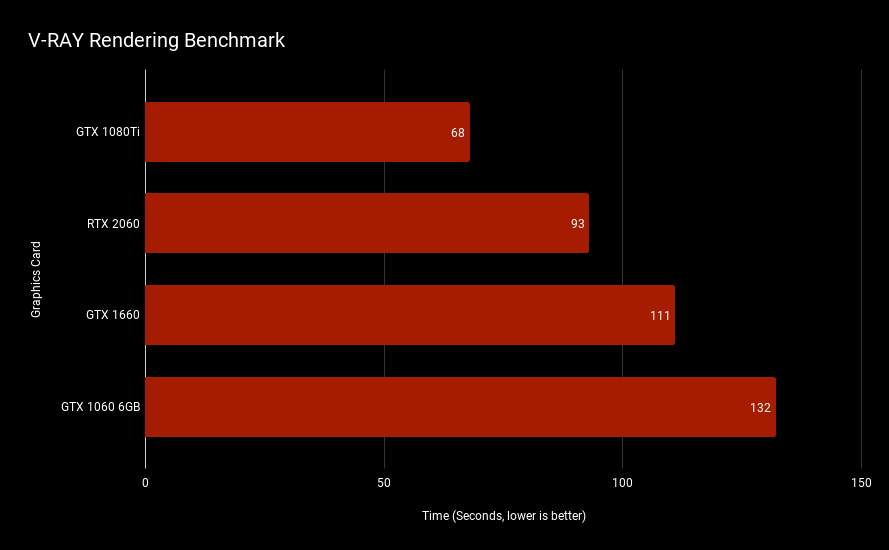 From V-RAY’s website : If you are not familiar with V-Ray, it is one of the leading raytracers in the world that is used in many different industries including architecture and automotive design. It has also been used in over 150 motion pictures and numerous episodic television series. It also won a Academy Award for Scientific and Technical Achievement in 2017.
From V-RAY’s website : If you are not familiar with V-Ray, it is one of the leading raytracers in the world that is used in many different industries including architecture and automotive design. It has also been used in over 150 motion pictures and numerous episodic television series. It also won a Academy Award for Scientific and Technical Achievement in 2017.
Making use of the CUDA cores in NVIDIA cards to run ray-traced rendering, V-RAY Benchmark is a great tool for measuring the raw compute power of these cards. Bear in mind that they do not make use of OpenGL or DirectX capabilities.
The GTX 1660 beats out the GTX 1060 by a respectable 16% margin, with the RTX 2060 17% faster. Expected, as it were.
Octane Render Benchmark
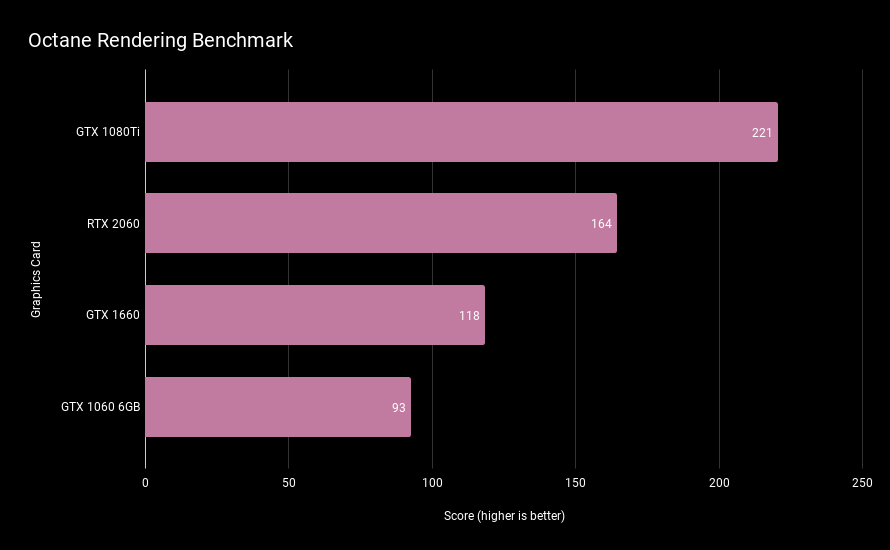 OctaneBench is a benchmark that uses graphics card resources to render four different scenes with three different rendering techniques (info channels provided by scene files, direct lighting and path tracing) to accurately gauge the amount of computational rendering potential that the chosen graphics card has.
OctaneBench is a benchmark that uses graphics card resources to render four different scenes with three different rendering techniques (info channels provided by scene files, direct lighting and path tracing) to accurately gauge the amount of computational rendering potential that the chosen graphics card has.
The results are predictable, as the GTX 1660 slots in between the GTX 1060 (+27%) and the RTX 2060 (-39%) – the GTX 1080Ti just screams off into the distance.
Ray-Tracing Benchmarks
N/A
A Word About Temperatures
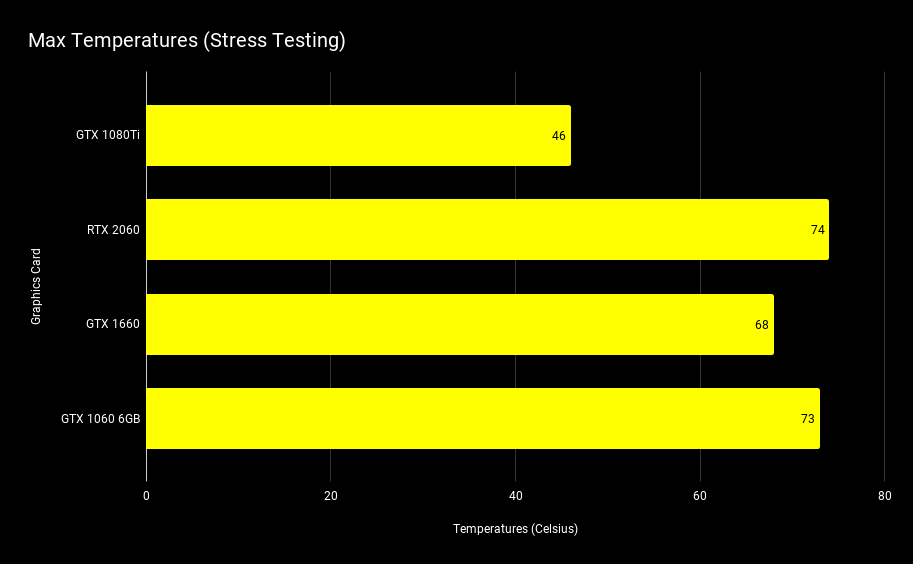 While ZOTAC hasn’t exactly wowed us before with the thermal performance of their cooling solutions (I was so unhappy with mine I decided to watercool everything), the GTX 1660 delights with lower thermal output compared to its predecessor and bigger RTX sibling. You won’t hit thermal throttling anytime soon with this card.
While ZOTAC hasn’t exactly wowed us before with the thermal performance of their cooling solutions (I was so unhappy with mine I decided to watercool everything), the GTX 1660 delights with lower thermal output compared to its predecessor and bigger RTX sibling. You won’t hit thermal throttling anytime soon with this card.
In Conclusion
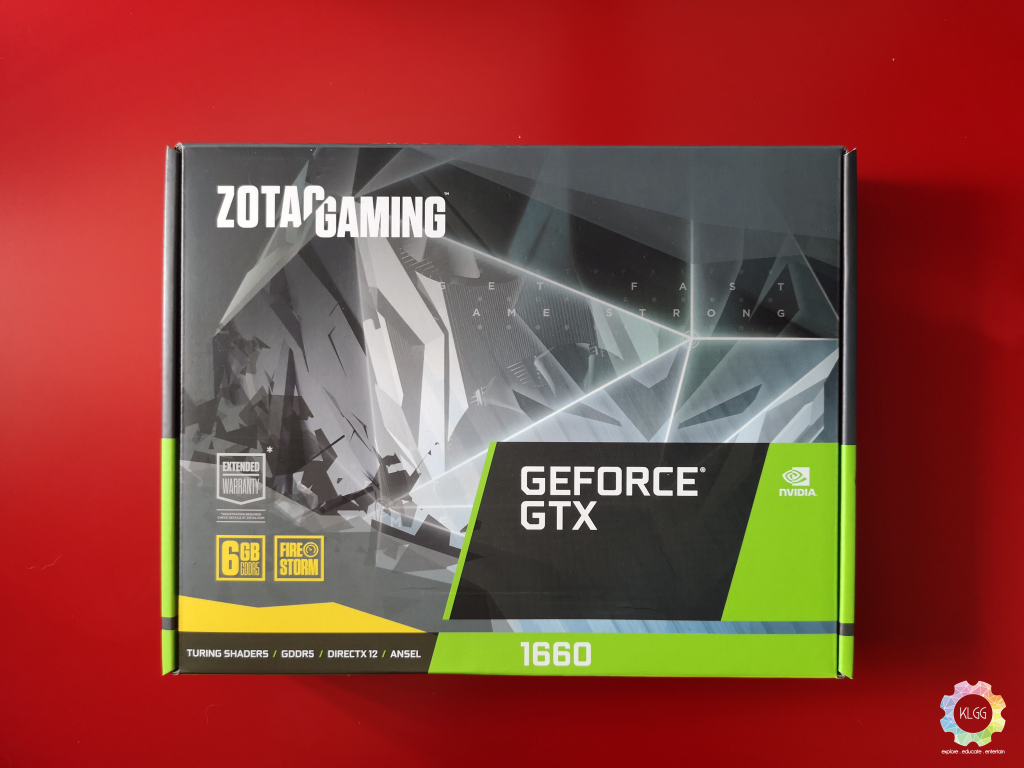 The GTX 1660 is a curious card. With the cheapest one on the market available for the relative pittance of RM939, there is a LOT of value to be found in this card. It outperforms its predecessor by an average margin of 27%, yet comes in at a lower MSRP than the GTX 1060 6GB. Home run, right?
The GTX 1660 is a curious card. With the cheapest one on the market available for the relative pittance of RM939, there is a LOT of value to be found in this card. It outperforms its predecessor by an average margin of 27%, yet comes in at a lower MSRP than the GTX 1060 6GB. Home run, right?
Not quite. Because of the rather annoying (if understandable) decision to keep the price low by using GDDR5 instead of GDDR6, the GTX 1660 is hampered. We also find ourselves in a curious position of being too close to the GTX 1660Ti, which utilises GDDR6 and has more CUDA cores – all for an RM300 price premium.
It’s difficult to definitively state that the GTX 1660 needs to exist. It does indeed offer a generational improvement over the GTX 1060 6GB – yet so does the GTX 1660Ti by an even bigger margin, at the GTX 1060 6GB’s launch MSRP.
So where does that leave us?
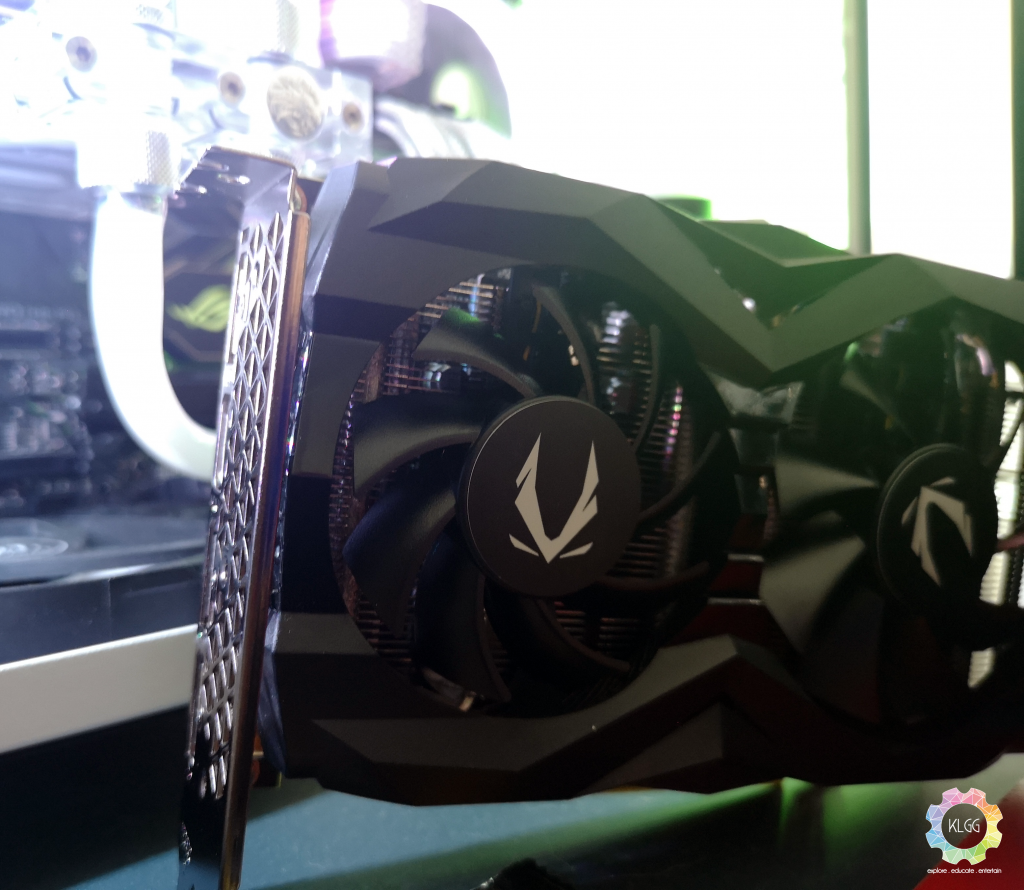 Taken in isolation, the GTX 1660 is a perfectly respectable 1080p gaming card, with just-about-acceptable performance at 1440p at medium to low settings. At a little over RM900, it’s pretty darn good value too. Yet our eyes flit to the slightly higher-priced GTX 1660Ti with its faster VRAM and more CUDA cores, and wish they’d just gone with that one instead.
Taken in isolation, the GTX 1660 is a perfectly respectable 1080p gaming card, with just-about-acceptable performance at 1440p at medium to low settings. At a little over RM900, it’s pretty darn good value too. Yet our eyes flit to the slightly higher-priced GTX 1660Ti with its faster VRAM and more CUDA cores, and wish they’d just gone with that one instead.
Taking a birds-eye view of the Turing range raises some questions about how NVIDIA have positioned their entire product line. As noted in our review of the RTX 2060 FE, it could have flown higher and farther with more than the measly 6GB of GDDR6 VRAM it was given. The Turing line as a whole could have been filled with killer cards at each pricepoint, if NVIDIA had been willing to sacrifice even a little of its rumoured profit margins. Instead, we have a product range that seems designed more by accountants than it was by consumer-focused policy decisions.
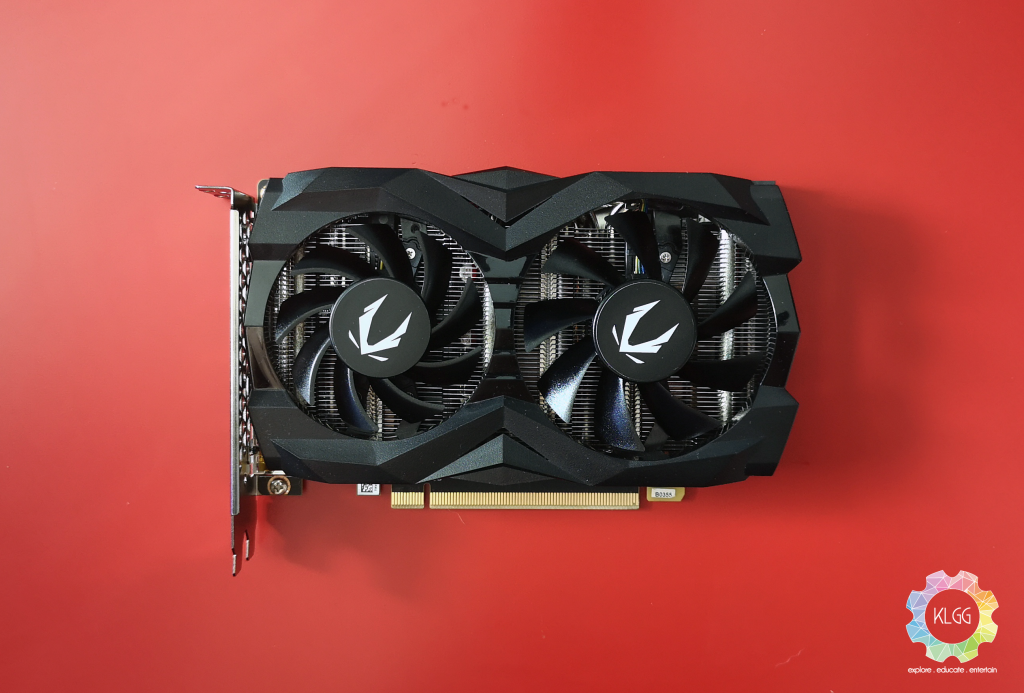 All of which makes us feel just a little bit meh about the GTX 1660. Our advice? Get one if you really can’t stretch that budget any further for a GTX 1660Ti, especially in the absence of anything resembling competition from AMD. Maybe NAVI will change the game and the landscape, but we’ll have to wait and see for that one.
All of which makes us feel just a little bit meh about the GTX 1660. Our advice? Get one if you really can’t stretch that budget any further for a GTX 1660Ti, especially in the absence of anything resembling competition from AMD. Maybe NAVI will change the game and the landscape, but we’ll have to wait and see for that one.
What Works
- Generational leap from 1060 to 1660 at a lower price
- Small footprint
- Excellent thermal performance
- Great value when viewed in isolation
What Doesn’t (Really) Work
- This is the pricepoint that the GTX 1660Ti should be in
- GDDR5? In 2019? Really?
- A product that feels like it was designed by accountants
What Doesn’t Work (At All)
- Nothing, really – this is a perfectly serviceable graphics card

